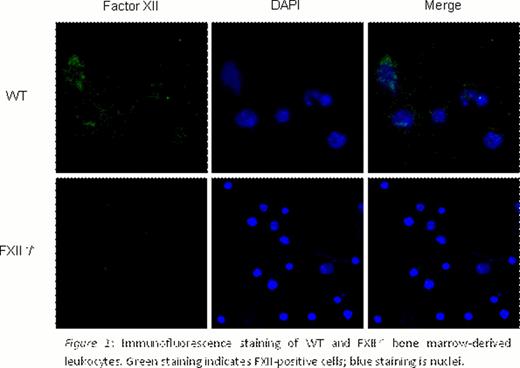Abstract
Abstract 616
Older investigations suggest that Factor XII (FXII) influences the inflammatory response. FXII deficient patients have reduced leukocyte migration into skin windows. In addition to bradykinin generation, FXII regulates the expression of monocyte FcγII receptor and stimulates monocytes and macrophages to release interleukin (IL)-1 and IL-6. In vitro, purified FXIIa corrects neutrophil aggregation and degranulation defects in FXII-deficient plasma. Our laboratory demonstrated that FXII signals through uPAR, β1 integrin and the EGFR to stimulate ERK1/2 and Akt phosphorylation (Blood 115:5111, 2010). The downstream consequences of this pathway are FXII-induced cell proliferation, growth and angiogenesis. Since FXII modulates wound angiogenesis, we examined the role for FXII in the inflammatory response and wound repair.
Exon 3 to 8–deleted FXII knockout mice (FXII−/−) were wounded by creating full thickness (5 mm) punch biopsies on their backs. The total surface area of inflammatory cells recruited to the injury site per 20X high power field (HPF) was determined and analyzed by Image J (NIH). We observed that on Day 1, FXII−/− mice exhibit significantly decreased recruitment of CD11 b–labeled inflammatory cells to injury sites compared with wild type mice (WT) [p=0.0136]. Similar results are observed when uPAR KO mice were compared to WT [p=0.0001], suggesting that leukocyte migration in part is mediated through this receptor. Next we determined the nature of cells in the wound sites. FXII−/− mice have reduced wound neutrophils (Gr-1 staining) and macrophages (F4-80 staining). On the thioglycolate (TG)-induced peritoneal inflammation assay, the number of peritoneal exudate cells (PECs) was measured in WT and FXII−/− mice 1 and 7 days following instillation. FXII−/− mice exhibit significantly decreased number of PEC's on days 1 and 7. Giemsa-Wright stain of peritoneal lavage fluid with manual differential counts or flow cytometry shows that there is a disproportionate decrease in neutrophil recruitment in peritoneal fluid of FXII−/− mice. Also, FXII−/− macrophages have reduced adherence to plastic. Identical assays performed on uPAR and bradykinin B2 receptor (B2R) KO mice did not reveal the same inflammatory defects; both uPAR and B2R KO mice have mild decreases in PEC cell numbers following TG instillation, but overall their inflammatory response remained intact. Investigations next determined if the leukocyte migration defect seen in FXII−/− mice is related to plasma FXII or an intrinsic leukocyte defect. On adoptive bone marrow (BM) transplantation experiments, WT bone marrow transplanted to FXII−/− mice corrects the TG-induced PEC migration defect after both 1 and 7 days from instillation. Alternatively, transplantation of FXII−/− bone marrow into WT mice produced a leukocyte migration defect. In order to further discriminate the contribution of FXII in leukocyte migration, we produced plasma FXII deficiency in WT mice using FXII siRNA. WT mice treated with FXII siRNA reduced plasma FXII activity to <10% at 24 h (T1/2= 6 h). These mice did not have a defect in PEC recruitment. In vivo infusion of purified FXII did not correct the leukocyte peritoneal migration defect in FXII−/− mice. Next we harvested BM from WT mice and isolated leukocytes to prepare bone marrow cell-derived mRNA. The mRNA was reverse-transcribed to cDNA and it demonstrates XII cDNA that shares sequence homology to hepatic XII from exons 2 through 14. Immunofluorescence staining of BM-derived leukocytes demonstrates XII-positive leukocytes with nuclear morphology resembling monocytes and neutrophils (Fig. 1). Finally although leukocyte FXII promotes their migration into wounds, FXII deficiency in leukocytes paradoxically is associated with improved rates of wound healing after punch biopsy.
These data indicate that there is a unique pool of FXII in leukocytes distinct from plasma (hepatic) FXII. Leukocyte FXII, not plasma FXII, is responsible for leukocyte function in wounds and inflammation sites. FXII−/− mice have attenuated wound injury and, paradoxically, improved wound healing rates. Modulation of leukocyte FXII is a target for promotion of wound healing.
No relevant conflicts of interest to declare.
Author notes
Asterisk with author names denotes non-ASH members.


This feature is available to Subscribers Only
Sign In or Create an Account Close Modal